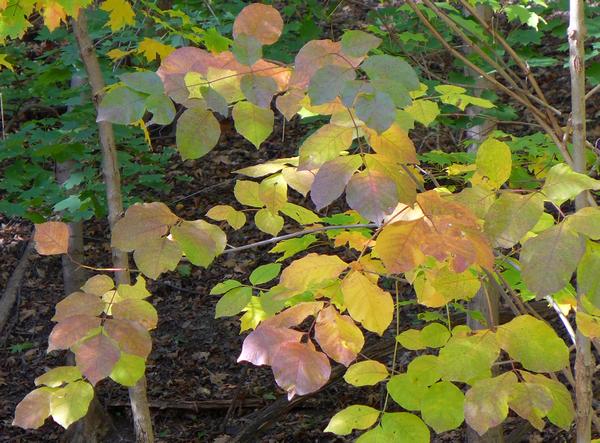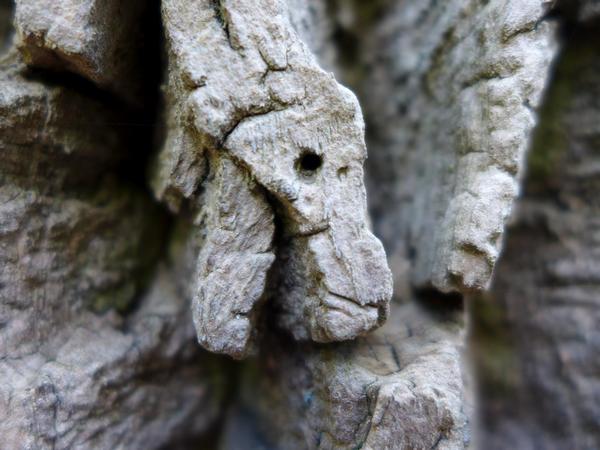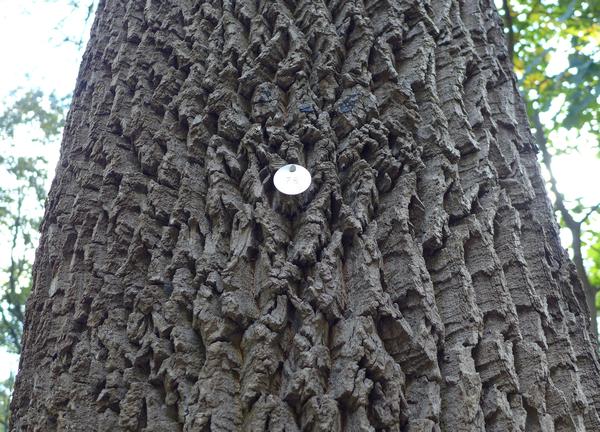
Two weeks ago I lamented that fall color is disappointing this year but I should have waited. The trees in Schenley Park looked better last week with red maples, yellow hickories, and this small tree reminding me of what we’ve lost.
Those pale green, yellow, orange and violet leaves are on a small ash tree whose trunk diameter is too small to be plagued by emerald ash borer … and now I’ve found out why.
Before the emerald ash borer (EAB) invasion(*), mature ash trees added pastel violet to the splash of color on our hillsides but now only the saplings are left.
Just across the trail from the ash sapling stands a mature ash that’s alive, though struggling. Some upper branches have died back and there are sucker branches below them. An old emerald ash borer hole shows what the mature tree was dealing with.

The old tree is alive because it received insecticide treatments during the height of the EAB invasion from a program of the Pittsburgh Parks Conservancy and the City of Pittsburgh. Beginning in 2011, 158 specimen ash trees were treated in the city parks. This one is #76 according to the metal tag.

Years later it appears that emerald ash borer numbers have dropped and it wasn’t because we used insecticides.
Scientists working on EAB biological control in Michigan found that many factors contributed to the emerald ash borer population collapse there.
“Woodpeckers, native and introduced parasitoids, intraspecific competition, disease, innate tree defenses, and reduced ash abundance contributed to the collapse of EAB populations.”
Notice that woodpeckers are at the top of the list!
Second on the list are four tiny parasitic insects that kill emerald ash borer larvae. Two native insects target emerald ash borers through the thin bark of saplings and at Michigan study sites scientists introduced two more parasitic insects from China, the emerald ash borer’s homeland, to get through the bark of mature ash trees.
Thanks to the hard work of scientists and arborists we may hope that our ash saplings will grow into mature ash trees.
Read more about ash tree biological controls at this U.S. Forest Service webpage.
(photos by Kate St. John)
(*) Emerald ash borer was first discovered in Michigan and Ontario in the summer of 2002. It was confirmed in western Pennsylvania in June 2007.
The dynamics of infestation and disease transmission are always very difficult to predict because there are so many interacting factors. Introducing a non-native species to control another non-native species rarely works. If you’d like an example of how that tactic can turn out disastrously, look into Cane Toads in Australia. Boosting natural defenses is generally a much better idea. Retaining dead standing trees (snags) to boost the quality of habitat for woodpeckers is something that individuals with forest stands on their property can do to help!
That is fantastic news! Maybe the native Chestnut can recover too someday.
Researchers at North Carolina State University are working on a hybrid Chestnut that is a 16:1 American Chestnut to Chinese Chestnut cross that is resistant to the blight. There are still young American Chestnuts that regenerate but die before they reach maturity to work with, so yes, some day there may be a return of the American Chestnut.
About 20 years ago I visited an experimental plot in Pennsylvania where they are growing the hybrid chestnuts.
I think my ash tree may be resistant or perhaps it successfully repelled the emerald ash borer? I noticed these bright green insects around the ash tree sometime in the ’90’s, before it became common knowledge in SW PA. Several years ago I noticed the green insects had disappeared. My ash tree continues to thrive. Knock on wood!